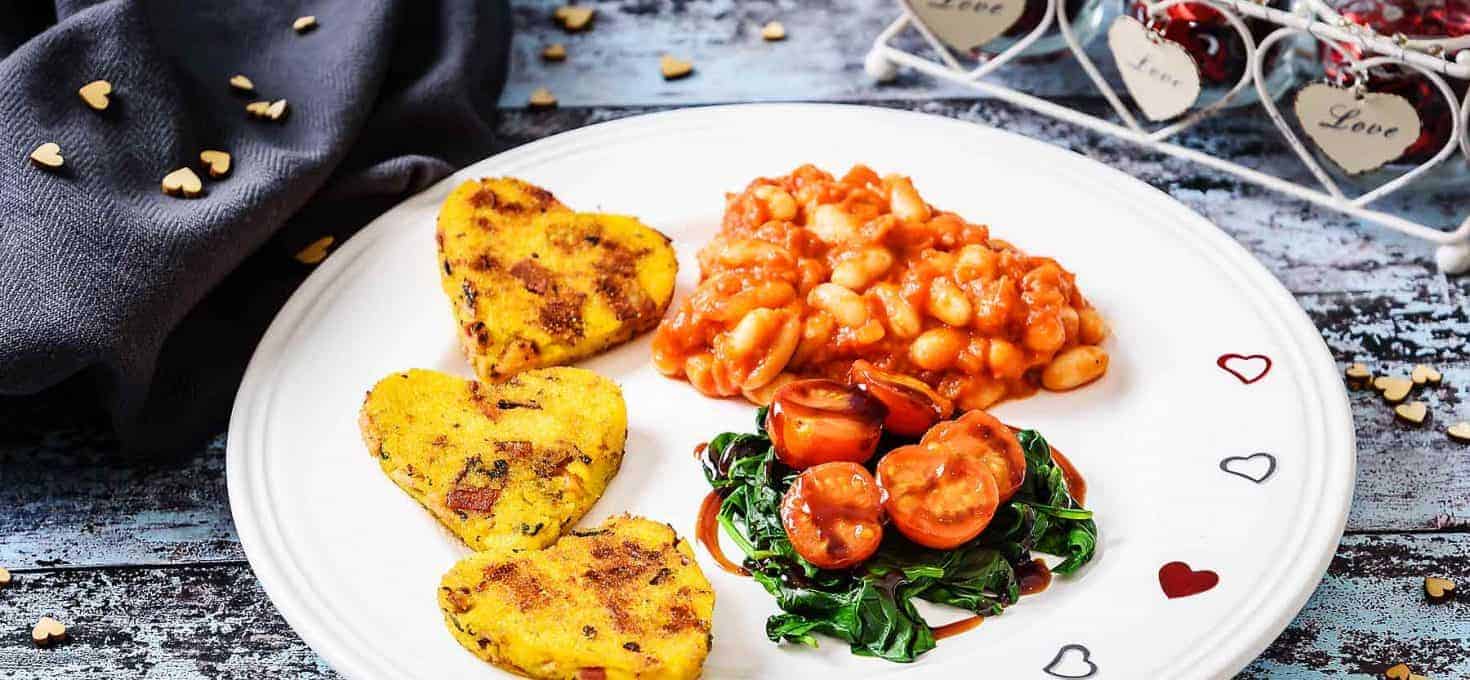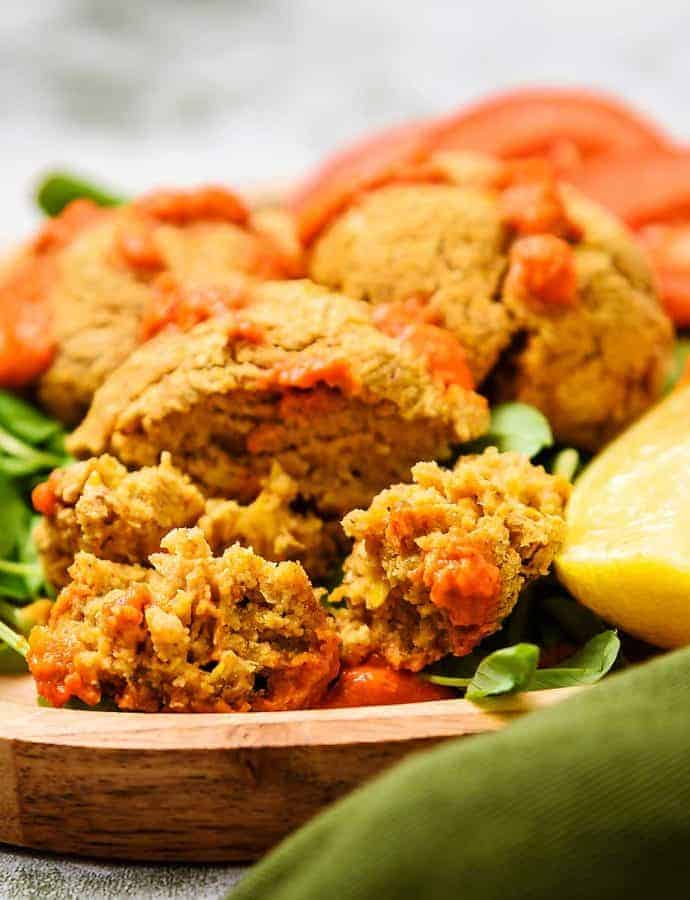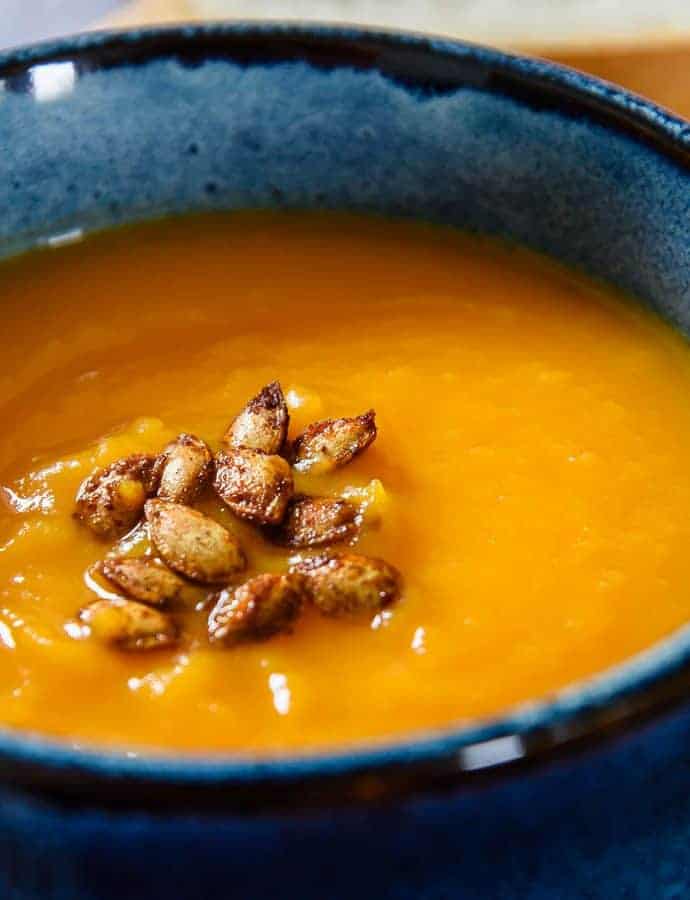I had so much fun making these Vegan Sausage & Bacon Polenta breakfast hearts. I adore polenta and always used to buy it in its cooked form. But it’s so much better when you can cook it yourself and make different shapes, and add different ingredients to change the flavours.
And, what’s more, this is a great recipe to prepare the day before so you don’t have to spend hours making and presenting this great looking dish!
Polenta has such a low fat content, it’s perfect for using as a base to build a recipe on.

Polenta
Polenta is actually ground corn, originating from Northern Italy. It is available in supermarkets in its cooked form as a slab that can be cut and fried, grilled or baked. But it has no added flavouring and can taste bland in its original form. Although I do use it sometimes, I really prefer polenta in its loose form to add my own flavours to it.
It is widely available in large supermarkets and health food shops, such as Holland and Barrett, in its loose form. Also note that polenta is called polenta and, although it is actually cornmeal, it is made from a variety of corn called flint corn. Cornmeal, however, is ground finer and is labeled cornmeal. Therefore, if a recipe calls for polenta, do not substitute it with cornmeal.
High in complex carbs, making you feel fuller for longer;
Naturally gluten-free;
Contains antioxidants;
Has approximately 8g of protein per 100g and 1.7g of fibre per 100g;
Versatile and easy to cook with.
How to make these Vegan Sausage & Bacon Polenta Hearts
Equipment you will need
With Valentine’s Day coming up, I decided to make heart shapes with the polenta and thought it would be great to share this recipe in the form of hearts so you can make a lovely valentine’s breakfast for someone you care about. That may be yourself, and rightly so. So why not treat yourself anyway! But once set, if hearts aren’t your thing and you just want a great breakfast, you can easily cut the polenta into slabs which will make enough for 4 servings.
So, please note, that when cut into hearts, the calories will be different from the serving size given for this recipe.

Once you have prepared all your ingredients, start by heating the oil in a frying pan and frying the onions over a medium-low heat for 2 minutes. Increase the heat, if necessary, to medium and add the mushrooms and continue to cook for another 2 minutes before adding the sausage and bacon. Cook for a further 3-4 minutes, reducing the heat as necessary, so as not to burn them until all the ingredients have browned. Then remove from the heat, stir in the kala namak, or sea salt, and set aside whilst you cook the polenta.
The reason I used Kala Namak, is because it has a wonderful ‘eggy’ flavour and, as this is predominately a breakfast recipe, I just wanted to add another breakfast element to it. However, you may find that you have sufficient salt content from the sausages and bacon and not want to add any salt at all.
Of course, there is no reason this recipe shouldn’t be made for any time of day. ???? Especially for a brunch, rather than breakfast!
It’s important to cook the mushrooms over a high enough heat to evaporate any liquid they release during cooking. If you add the sausage and bacon before the liquid has evaporated, the sausage and bacon will become soggy and not cook properly. Therefore, if there is still mushroom liquid in the pan after cooking over a medium heat for 2 minutes, raise the heat a little and stir continuously so the mushrooms and onions do not burn, until the liquid has gone.
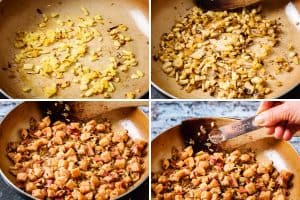
Please note that I used Linda McCartney vegan sausages and naked, without the oink, bacon rashers and this is what I have based the calories count on. When choosing sausages to cut up, I find that it’s best not to use sausages with skin on. If using frozen sausages, as I did, cut them before they are fully defrosted. This way you will not end up with mushy pieces of sausage. The naked, without the oink, bacon is soft and therefore works better when mixing into the polenta.
If you try different brands in this recipe please leave me a comment in the comments box below as I would love to know how they worked. ????????
Now you can cook the polenta. It’s actually a lot easier than you might think and gets easier the more you make it.
So, in a large saucepan, place the freshly boiled water (not in the ingredients photo) and stir in the stock powder. Bring the water/stock up to a boil and then reduce the heat to low. This is because the polenta will ‘spit’ if the temperature makes the water/stock continue to boil and bubble.
As soon as you have reduced the heat, pour the polenta into the pan and stir continuously so you get an even consistency. Either a wooden spoon or a whisk will work fine to do this.
Continue to cook over a low heat, stirring continuously so the polenta does not stick to the pan, for 3-4 minutes. When cooked enough, the polenta will not ‘run-back’ when you pull a spoon through the bottom of the pan.

You are now ready to turn off the heat and add the sausage and bacon mixture. When you get to this stage, the polenta is actually cooked and very tasty, and thus, can be eaten straight away. But it is even more tasty when left and then gently fried to give a crispy coating. So you will need to work quite quickly as the polenta will start to set as soon as it comes off the heat and thus, will need pouring into your mould immediately and the top smoothing to an even level all over.
I used a silicone mould measuring 19cm x 19cm (7½ x 7½ inches), which is great as you don’t have to line or grease it. But if you are using a solid mould it’s a good idea to line it with clingfilm so that there is no risk of the polenta sticking to the mould when you turn it out.
Basically, you can use any shape, it doesn’t have to be square. But please remember that if you use a smaller mould the polenta will be thicker and if you use a bigger mould, the polenta will be thinner.
Once in your mould, leave to cool and completely set. This, if placed in a cool area, should take about an hour. And, of course, you can place it in the fridge to speed this up once it has cooled enough.
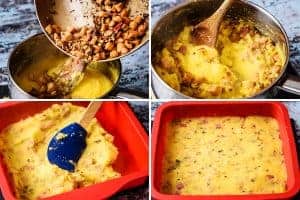
When the polenta has completely cooled and set, you can turn it out onto a chopping board. The easiest way to do this, if you have used a solid mould, is to place the chopping board over the top and then, holding the board in place, turn the mould over. The polenta should fall out easily if you have lined the mould with clingfilm.
If you are using a silicone mould, it can be a little more tricky as silicone is not rigid, and therefore, I always use a sheet of oven liner and my hand to hold the polenta as I turn the mould over.
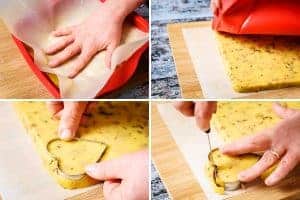
You are then ready to cut the polenta as you choose! If using a cutter, just run a sharp knife around the bottom to ensure there are no bits that will spoil the shape.
Here are the dimensions of the cutter I used. It’s the same one I used for my vegan oat & apricot cookies.
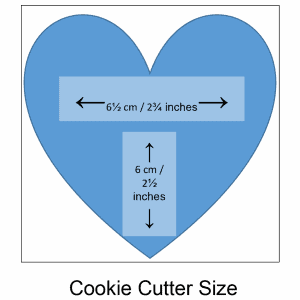
I was able to cut out 8 hearts of this size and had some offcuts left. If you choose to cut out heart shapes, just keep any offcuts and fry them up the next day!
However, if you do not want to cut out shapes, then just cut the polenta into slabs. Of which you can make 8 pieces which will serve 4 people.

To reheat, heat a little oil in a non-stick pan and gently fry the hearts/slabs over a medium-low heat for 3 minutes on each side, until golden and crispy.

Whilst the polenta is frying, next cook the tomatoes and spinach, if using. Do this by heating a little oil in a pan over a medium heat and fry the tomatoes for 1 minute, add a little of the balsamic drizzle to coat the tomatoes, and fry for another 30-60 seconds. Turn off the heat and leave the tomatoes to rest.

Then place the spinach in a microwavable bowl with a little water and cook on full power for about 3 minutes, until wilted. Drain the spinach and serve on warmed plates, topped with the tomatoes and the remaining balsamic drizzle, with the polenta and homemade beans for a delicious breakfast, brunch, lunch or whenever you fancy it ????.
Please note that it is better not to measure out the balsamic drizzle until you are ready to use it. This is because, when left in a bowl, the balsamic drizzle can thicken and will not drizzle in the same way. It is best used straight from the bottle if you are not too worried about exact measures.
And, whichever way you choose to cut the polenta, it tastes amazing!

Other Polenta Recipes
Vegan Polenta Plum Tomato Loaf
Vegan Polenta Party Bites
Don’t forget to drop me a comment when you have tried this recipe ????????
Happy polenta heart making and ENJOY!
Vegan Sausage & Bacon Polenta
- 30/01/2021
- Serves 4 when cut into slabs
- 1 hr 30 min
- 190 Cals/Serving
- Print this
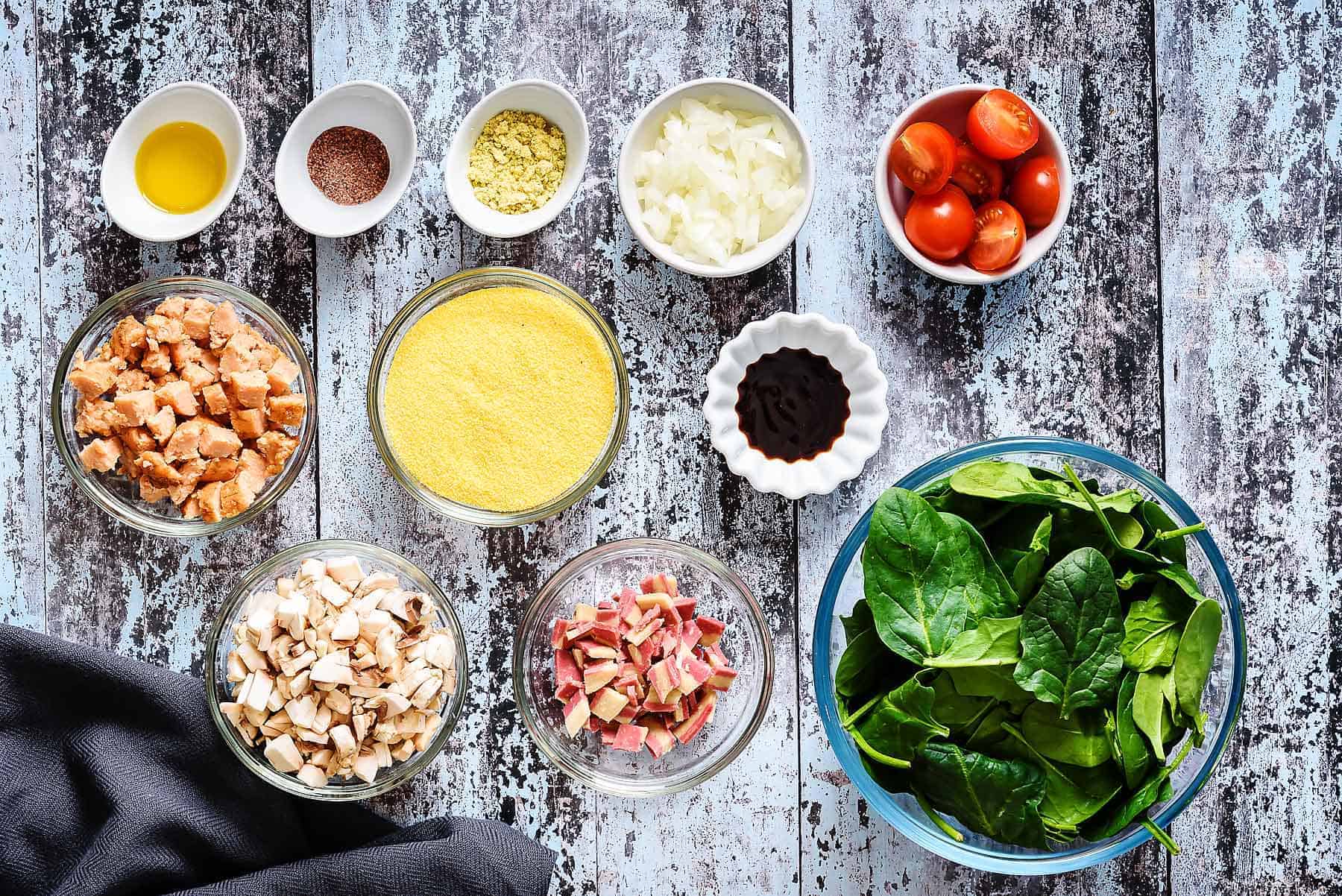
Ingredients
- For the Polenta
- 10 ml / 2 teaspoons oil, plus extra for frying before serving
- ½ small onion, finely diced
- 2 vegan sausages, finely diced
- 2 rashers vegan bacon, finely diced
- 4 closed cup mushrooms, diced
- 1.25 ml / ¼ teaspoon kala namak (black Hymalayan salt or sea salt)
- 400 ml / 13½ floz freshly boiled water
- 15 ml / 1 tablespoon stock powder
- 100g / 3½ oz polenta
- To Serve
- Oil for frying
- 5 cherry tomatoes, halved
- 2 large handfuls of spinach leaves, washed
- 10 ml / 2 teaspoons balsamic drizzle
Directions
- Step 1
- Heat the oil and add the onion. Fry over a medium-low heat for 2 minutes, then add the mushrooms and continue to cook for another 2 minutes.
- Step 2
- Next, add the sausage and bacon and continue to cook 3-4 minutes, until all ingredients have browned.
- Step 3
- Remove from the heat and stir in the kala namak. (However you can use sea salt if you do not have kala namak.) Set aside.
- Step 4
- Next, in a large pan add the water and stir in the stock powder. Bring to a boil, reduce the heat and immediately stir in the polenta, stirring continuously for 3-4 minutes. You will know when the polenta is cooked as you will be able to move the spoon across the bottom of the pan and the polenta will not run back.
- Step 5
- Remove from the heat and quickly stir in the sausage and bacon mixture.
- Step 6
- Pour into a container – I used a silicone dish that measured approximately 19cm x 19cm (7½ x 7½ inches), and leave to cool and set. This takes about an hour when left in a cool place.
- Step 7
- At this point, you can cover and leave it in the fridge for a day if making ahead of time.
- Step 8
- When ready to serve, carefully turn out of the container by placing a chopping board on top and turning upside down. Please see notes above if using a silicone container like I did.
- Step 9
- Now you can cut the polenta into heart shapes for a special valentines breakfast or into slabs – see notes above relating to calorie content and portion sizes.
- Step 10
- Heat a little oil in a non-stick pan and gently fry the hearts, or slabs, over a medium-low heat for 3 minutes on each side, until they have turned golden and crisped up a little.
- Step 11
- If using tomatoes and spinach to serve, whilst the polenta is frying, heat a little oil in a small pan and add the tomatoes. Fry over a medium heat for 1 minute, add a little of the balsamic drizzle and coat the tomatoes, continuing to fry for another 30-60 seconds. Turn off the heat and leave to rest in the pan.
- Step 12
- Next, place the spinach in a microwavable bowl with a little water. Microwave on full power for 2-3 minutes until the spinach has wilted. Strain and serve on warm plates, top the spinach with the tomatoes, drizzle over the remaining balsamic drizzle and add the polenta hearts/slabs to the plate. This recipe is great served with my home-made beans.

